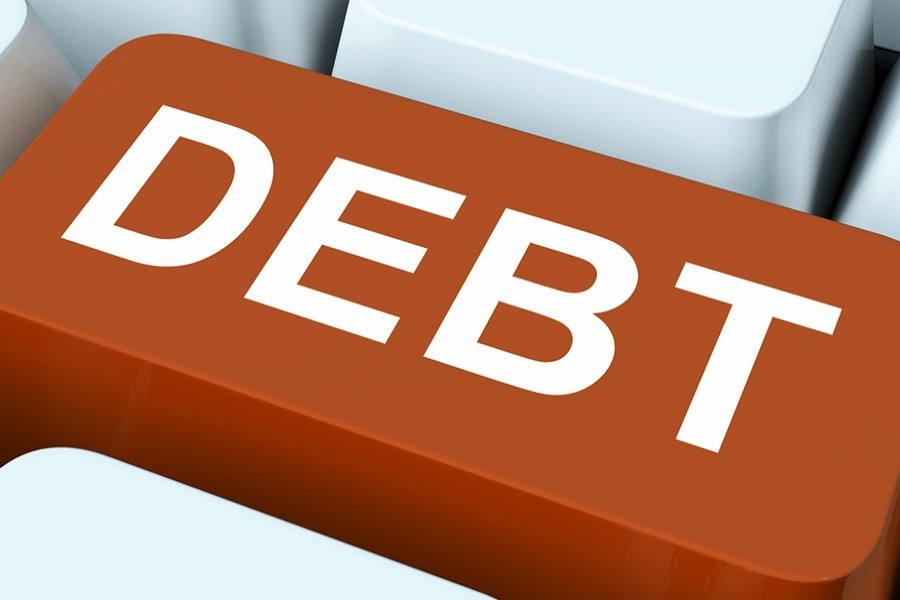Bangladesh's debt servicing to overseas lenders is rising year-on-year, as the government opts for higher hard-term borrowing in recent years, analysts said on Monday.
The debt servicing against different medium- to long-term loans (MLTLs) from the external development partners gone up by over 79 per cent in last nine years.
According to the Economic Relations Division (ERD), the government repaid US$1.73 billion loans as principal and interest in last fiscal year (FY), 2019-20, which was 79.41 per cent higher than that of $966.5 million in FY 2012.
Of the $1.73 billion repayment, $477.4 million was interest and $1.25 billion was principal amount of the outstanding loans.
The loan repayment is still showing a higher trend, as the government repaid $1.60 billion worth of interest and principal during July-April period of the current fiscal against the total outstanding loans.
Among the $1.60 billion repayment, $427.37 million was interest and $1.17 billion was principal amount of the loans, the ERD data showed.
Analysts and officials said the government in recent years opted for higher borrowing, including some non-concessional and hard-term loans from foreign lenders, resulting in higher repayments.
Besides, the development partners, including the larger lenders - the World Bank (WB), the Asian Development Bank (ADB), Japan and China, increased their interest rate and service charges as well as reduced the grace period.
The lenders did these after Bangladesh's graduation to a lower middle income country (LMIC) in FY 2016, which was also a reason behind the steep rise in the foreign loan repayment, they added.
Since grace period of many of the recently borrowed non-concessional and hard loans had been over, the country needed to repay interests and principal amounts simultaneously, resulting in the higher repayments year-on-year, said a senior ERD official.
Bangladesh takes loans from different development partners, including the WB, the ADB, Japan, China and the Islamic Development Bank (IDB), to develop its infrastructure and cut poverty.
Although the country borrows from different bilateral and multilateral lenders every year, it also has to repay the loans with principal amounts and interests for the previous outstanding loans.
The debt servicing started to jump from FY 2018, when the government repaid $1.41 billion funds, a 25.45 per cent year-on-year high, against the concessional and hard-term loans and different ODAs (official development assistances), the ERD data showed.
In FY 2017, Bangladesh needed to repay $1.23 billion worth of interest and principal against the ODA loans. In FY 2019, the loan repayment amount picked up to $1.59 billion, and in FY 2020 to $1.73 billion.
When asked, an additional secretary at the ERD told the FE that the debt servicing would rise in the coming years at higher rates, as the government took many non-concessional loans with harder terms and conditions in recent years.
"As Bangladesh is going to graduate from the least developed country (LDC) to a developing nation in 2024, the loans will be harder in the future."
For example, the government took some hard loans from China, Russia, the WB and the ADB in recent years, which enhanced the repayment amount every year, the ERD official added.
The loans started getting costlier since FY 2016 when Bangladesh graduated to a LMIC.
Bangladesh's largest multilateral donor - the WB - reduced maturity period for its loans to 30 years and grace period to 5-7 years over the last few years instead of its previous 40 years and 10 years respectively.
Besides, the agency added 1.0 per cent interest rate afresh with its 0.75 per cent service charge over the last few years for lending.
Similarly, the second largest multilateral donor - the ADB - also enhanced lending from its non-concessional window - Ordinary Capital Resources (OCR), which is a LIBOR-based lending arm.
The loans from its soft window - Asian Development Fund (ADF) - was decreasing year-on-year after the graduation of Bangladesh as a LMIC.
The largest bilateral donor - Japan - also made its lending terms harder, as it was charging 0.10 per cent interest rate in recent years against 0.01 per cent a few years back.
Both the donors also reduced their loan maturity and grace periods for lending to Bangladesh.
"We repaid only $1.05 billion worth of principal and interest five years back in FY 2016 against different MLTLs, which now increased by 65 per cent to $1.73 billion in FY 2020," noted the ERD official.
Centre for Policy Dialogue (CPD) Research Director Dr Khandker Golam Moazzem said as the government had gone for costly borrowing in recent years, especially for the China-funded projects, loan repayment in the balance sheet was rising day-by-day.
After graduation to non-LDC, Bangladesh would have to borrow loans at higher rates, which would further increase the repayment amount in the near future.
So, the country needs to ensure best use of the costly loans by ensuring quality implementation of projects as well as checking misuse and leakage of fund, he added.


